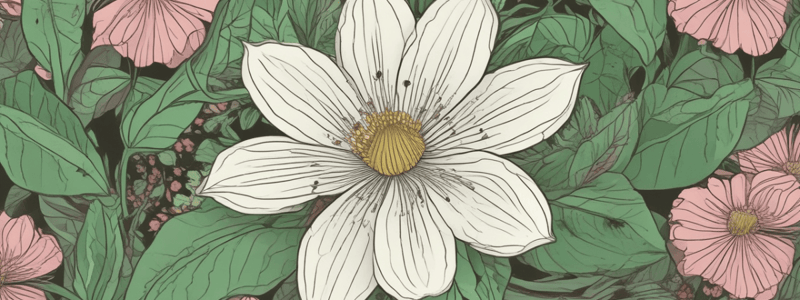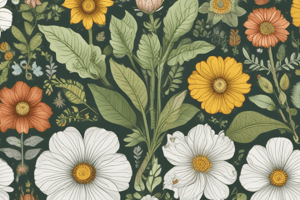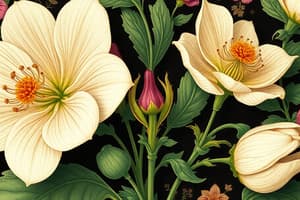Podcast
Questions and Answers
What is the primary role of a flower in a plant?
What is the primary role of a flower in a plant?
- To ensure pollination and seed formation (correct)
- To store nutrients and minerals
- To protect the plant from harsh weather
- To regulate water intake in the plant
What is the term for the scientific study of plants?
What is the term for the scientific study of plants?
- Ecology
- Floristry
- Horticulture
- Botany (correct)
What are the four circular layers of specialized tissues in a flower structure?
What are the four circular layers of specialized tissues in a flower structure?
- Calyx, corolla, androecium, and gynoecium (correct)
- Petal, sepal, stamen, and pistil
- Root, stem, leaf, and flower
- Reproductive, vegetative, structural, and functional
What type of flower has all four whorls present?
What type of flower has all four whorls present?
What is the term for plants that produce flowers and fruit?
What is the term for plants that produce flowers and fruit?
What is the function of the calyx in a flower?
What is the function of the calyx in a flower?
What is the term for the collective parts of the male whorl of a flower?
What is the term for the collective parts of the male whorl of a flower?
What type of flowers do corn and most grasses produce?
What type of flowers do corn and most grasses produce?
What is the process called when pollen is transferred onto the stigma and moves toward the ovule?
What is the process called when pollen is transferred onto the stigma and moves toward the ovule?
What is the term for the collective parts of the outer whorls of a flower, consisting of the calyx and corolla?
What is the term for the collective parts of the outer whorls of a flower, consisting of the calyx and corolla?
What is the function of the style in the process of pollination?
What is the function of the style in the process of pollination?
What is the term for the collective female structures of a flower?
What is the term for the collective female structures of a flower?
What is the sticky part of the female flower structure that catches pollen grains?
What is the sticky part of the female flower structure that catches pollen grains?
What is the function of the anther in the male flower structure?
What is the function of the anther in the male flower structure?
What is the term for the whorl of the flower that contains the carpel?
What is the term for the whorl of the flower that contains the carpel?
Flashcards are hidden until you start studying
Study Notes
What is a Flower?
- Flowers are modified leaves attached to the stem of a plant, containing complex reproductive organs and specialized cells.
- They serve a reproductive role to ensure pollination and seed formation are successful.
- The showy petals surround the complex reproductive structures within the feathery male pollen-producing stamen, which encircles the dark female pistil at the flower center.
The Study of Flowers
- The scientific study of plants is called botany.
- Botanists study the structures and functions of plants, their evolutionary relationships, growth, change, reproduction, and more.
- The study of the anatomy of a flower is a specialty within the field of botany.
Basic Structure of a Flower
- The basic flower structure includes four circular layers of specialized tissues called whorls.
- The structure of flower whorls, from outer to innermost, is: calyx (sepals), corolla (petals), androecium (male reproductive structures), and gynoecium (female reproductive structures).
Complete vs. Incomplete Flowers
- Complete flowers have all four whorls present: sepals, petals, and both male and female reproductive structures.
- Incomplete flowers are missing one of the four whorls.
- Examples of plants with incomplete flowers include corn and most grasses, which lack petals (corolla whorl) and sometimes sepals (calyx whorl).
- Other examples of incomplete flowers are found on some squash and cucumber plants, which have sepals and petals but lack either male or female reproductive whorls.
Whorls
- Whorls are specialized layers that make up the structure of a flower.
- Each whorl has a specific reproductive function.
- The whorls, moving from outer to innermost, are: calyx, corolla, androecium, and gynoecium.
- Calyx (sepals) protects the flower bud as it forms.
- Corolla (petals) attracts pollinators.
- Androecium (male part) consists of one or more stamens that produce pollen.
- Gynoecium (female part) consists of one or more carpels that produce ovules.
Male and Female Parts of a Flower
- The male whorl is called the androecium, which consists of the flower parts that produce pollen.
- The female whorl is called the gynoecium, which is responsible for creating the ovule.
- Pollination occurs when pollen is transferred onto the stigma and moves toward the ovule.
Female Structure of a Flower
- The female structures of a flower are collectively called the gynoecium.
- The gynoecium contains the carpel, which consists of the stigma, style, and ovary.
- The stigma is sticky to trap pollen grains.
- The style is a thin tube that connects the stigma with the ovary.
- The ovary contains ovules, or female sex cells.
Male Structure of a Flower
- The male structure of a flower is called the androecium.
- One or more stamens make up the androecium.
- Each stamen consists of an anther that produces pollen and a filament that supports the anther.
Studying That Suits You
Use AI to generate personalized quizzes and flashcards to suit your learning preferences.




